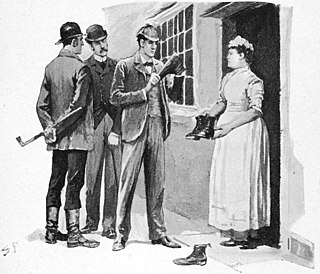
Detective fiction is a subgenre of crime fiction and mystery fiction in which an investigator or a detective—whether professional, amateur or retired—investigates a crime, often murder. The detective genre began around the same time as speculative fiction and other genre fiction in the mid-nineteenth century and has remained extremely popular, particularly in novels. Some of the most famous heroes of detective fiction include C. Auguste Dupin, Sherlock Holmes, Kogoro Akechi, and Hercule Poirot. Juvenile stories featuring The Hardy Boys, Nancy Drew, and The Boxcar Children have also remained in print for several decades.
Mystery, The Mystery, Mysteries or The Mysteries may refer to:

Crime fiction, detective story, murder mystery, crime novel, mystery novel, and police novel are terms used to describe narratives that centre on criminal acts and especially on the investigation, either by an amateur or a professional detective, of a crime, often a murder. Most crime drama focuses on criminal investigation and does not feature the courtroom. Suspense and mystery are key elements that are nearly ubiquitous to the genre.

Ellery Queen is a pseudonym created in 1928 by the American detective fiction writers Frederic Dannay (1905–1982) and Manfred Bennington Lee (1905–1971). It is also the name of their main fictional detective, a mystery writer in New York City who helps his police inspector father solve baffling murder cases. From 1929 to 1971, Dannay and Lee wrote around forty novels and short story collections in which Ellery Queen appears as a character.

John Dickson Carr was an American author of detective stories, who also published using the pseudonyms Carter Dickson, Carr Dickson, and Roger Fairbairn.

The "locked-room" or "impossible crime" mystery is a type of crime seen in crime and detective fiction. The crime in question, typically murder, is committed in circumstances under which it appeared impossible for the perpetrator to enter the crime scene, commit the crime, and leave undetected. The crime in question typically involves a situation whereby an intruder could not have left; for example the original literal "locked room": a murder victim found in a windowless room locked from the inside at the time of discovery. Following other conventions of classic detective fiction, the reader is normally presented with the puzzle and all of the clues, and is encouraged to solve the mystery before the solution is revealed in a dramatic climax.

Mystery is a fiction genre where the nature of an event, usually a murder or other crime, remains mysterious until the end of the story. Often within a closed circle of suspects, each suspect is usually provided with a credible motive and a reasonable opportunity for committing the crime. The central character is often a detective, who eventually solves the mystery by logical deduction from facts presented to the reader. Some mystery books are non-fiction. Mystery fiction can be detective stories in which the emphasis is on the puzzle or suspense element and its logical solution such as a whodunit. Mystery fiction can be contrasted with hardboiled detective stories, which focus on action and gritty realism.

The Moonstone: A Romance by Wilkie Collins is an 1868 British epistolary novel. It is an early example of the modern detective novel, and established many of the ground rules of the modern genre. Its publication was started on 4 January 1868 and was completed on 8 August 1868. The story was serialised in Charles Dickens's magazine All the Year Round. Collins adapted The Moonstone for the stage in 1877.
Clayton Rawson was an American mystery writer, editor, and amateur magician. His four novels frequently invoke his great knowledge of stage magic and feature as their fictional detective The Great Merlini, a professional magician who runs a shop selling magic supplies. He also wrote four short stories in 1940 about a stage magician named Don Diavolo, who appears as a minor character in one of the novels featuring The Great Merlini. "Don Diavolo is a magician who perfects his tricks in a Greenwich Village basement where he is frequently visited by the harried Inspector Church of Homicide, either to arrest the Don for an impossible crime or to ask him to solve it."

The Mystery of the Yellow Room is a mystery novel written by French author Gaston Leroux. One of the first locked-room mystery novels, it was first published serially in France in the periodical L'Illustration from September 1907 to November 1907, then in its own right in 1908.
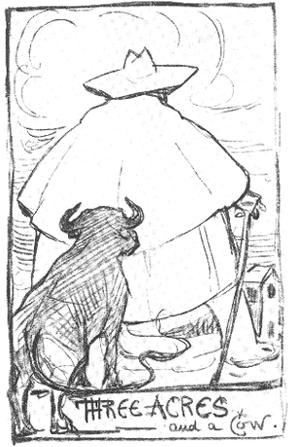
Dr. Gideon Fell is a fictional character created by John Dickson Carr. He is the protagonist of 23 mystery novels from 1933 through 1967, as well as a few short stories. Carr was an American who lived most of his adult life in England; Dr. Fell is an Englishman who lives in the London suburbs.
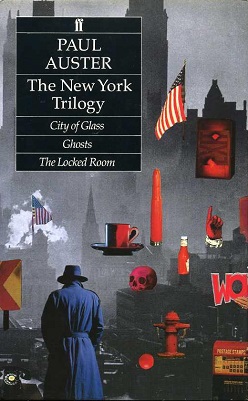
The New York Trilogy is a series of novels by American writer Paul Auster. Originally published sequentially as City of Glass (1985), Ghosts (1986) and The Locked Room (1986), it has since been collected into a single volume. The Trilogy is a postmodern interpretation of detective and mystery fiction, exploring various philosophical themes.

Ellery Queen is an American TV drama series, developed by Richard Levinson and William Link, who based it on the fictional character of the same name. The series ran for a single season on NBC from September 11, 1975, to April 4, 1976. Jim Hutton stars as the eponymous sleuth, along with David Wayne as his father, Inspector Richard Queen.
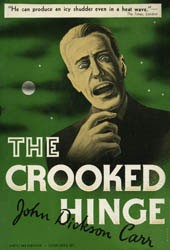
The Crooked Hinge is a mystery novel (1938) by detective novelist John Dickson Carr. It combines a seemingly impossible throat-slashing with elements of witchcraft, an automaton modelled on Maelzel's Chess Player, and the story of the Tichborne Claimant. It was dedicated to fellow author Dorothy Sayers "in friendship and esteem".

Kosuke Kindaichi is a fictional Japanese detective created by Seishi Yokomizo, a renowned mystery novelist. His first case, The Honjin Murders, is a novel of a locked room murder in an old family house, which many people regard as one of the best Japanese detective novels, was published in 1946. Kindaichi went on to feature in another 76 novels, selling more than 55 million books and appearing in numerous film, television and stage adaptations.
An inverted detective story, also known as a "howcatchem" and sometimes "howdunit", is a murder mystery fiction structure in which the commission of the crime is shown or described at the beginning, usually including the identity of the perpetrator. The story then describes the detective's attempt to solve the mystery. There may also be subsidiary puzzles, such as why the crime was committed, and they are explained or resolved during the story.

The Chinese Orange Mystery is a novel that was written in 1934 by Ellery Queen. It is the eighth of the Ellery Queen mysteries.

The Dead Man's Knock, first published in 1958, is a detective story by John Dickson Carr which features Carr's series detective Gideon Fell. This novel is a mystery of the type known as a locked room mystery.
The Mystery Writers of Japan Awards are presented every year by the Mystery Writers of Japan. They honor the best in crime fiction and critical/biographical work published in the previous year.
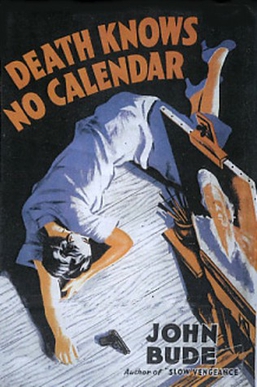
Death Knows No Calendar is a 1942 detective novel by the British writer John Bude. It was a stand-alone novel rather than one featuring his regular detective Superintendent Meredith. In this case the investigation is led by a former army officer Major Boddy. It takes the former of a locked room mystery with a closed circle of suspects, both popular variations of the genre during the period. Originally published by Cassell, in 2020 it was reissued by the British Library Publishing in a single edition with another Bude novel Death in White Pyjamas, as part of a series of republished crime novels from the Golden Age of Detective Fiction.













